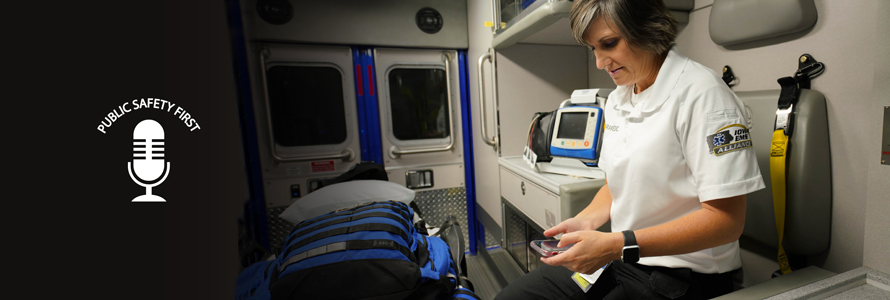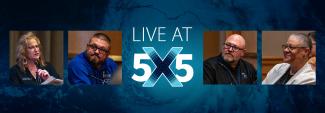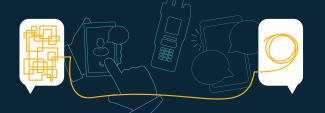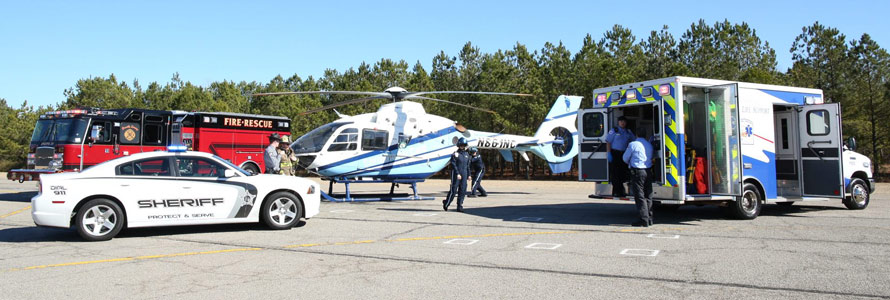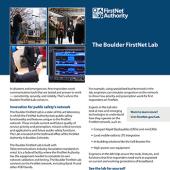Summary
Paul Patrick, FirstNet Authority Board Member and Division Director for Family Health and Preparedness at the Utah Department of Health, reflects on his career and how FirstNet has advanced capabilities for EMS, including telehealth. He also explains how the Centers for Medicare and Medicaid Services’ Emergency Triage, Treat, and Transport Model is changing the field of emergency medicine.
Guest
Dave Buchanan
FirstNet Authority Executive Director of Public Safety Advocacy
Paul Patrick
FirstNet Authority Board Member and Division Director, Family Health and Preparedness, Utah Department of Health
Transcript
Preview
Narrator: You're listening to Public Safety First, a podcast to help you learn about the First Responder Network Authority and how you can be part of the future of public safety technology.
And now, your host.
Dave Buchanan: Welcome to the Public Safety First podcast. My name is Dave Buchanan, and I'm delighted to be joined today by Paul Patrick. Paul Patrick is a member of our FirstNet Board. He represents the EMS community on our Board. Paul's the former EMS Director for the State of Utah, and he previously worked with FirstNet and has been known to us for a very long time, worked with us on our Public Safety Advisory Committee, where he also served as our chair of that committee. Welcome to the podcast, Paul.
Narrator: You're listening to Public Safety First, a podcast to help you learn about the First Responder Network Authority and how you can be part of the future of public safety technology.
And now, your host.
Dave Buchanan: Welcome to the Public Safety First podcast. My name is Dave Buchanan, and I'm delighted to be joined today by Paul Patrick. Paul Patrick is a member of our FirstNet Board. He represents the EMS community on our Board. Paul's the former EMS Director for the State of Utah, and he previously worked with FirstNet and has been known to us for a very long time, worked with us on our Public Safety Advisory Committee, where he also served as our chair of that committee. Welcome to the podcast, Paul.
Paul Patrick: Thank you, Dave. It's really a pleasure to be here and I'm looking forward to it.
Dave Buchanan: Great. So, give our listeners a little bit of background on your career. How did you come into public safety and what have you been doing recently in addition to your work with the Board?
Paul Patrick: I first started when I was young, just out of high school and into college and had a great interest in emergency medical services and one of the teachers at the college I was attending wrote textbooks for EMT training. So, obviously I got hooked right up first and went through training and certified. I've spent over 30 years now in emergency medical services, especially in rural Utah. And I know what it's like to be a first responder. I'm so passionate about that. And the benefits that paramedics and EMTs play. There was an opportunity to go to work for the state of Utah and the Department of Health. It was for emergency medical services, which was pretty exciting for me. And so, I was able to travel all over the state. And from that I took an interest in communications and worked with everything from the beginning of FirstNet with the initiatives that were going on through the legislation, through the D-block and all of that. So, I've had a lot of experience and have grown and a lot of great mentors who have helped me along the way.
One of the things that I'm very passionate about is telehealth. As I look back upon my experience in emergency medical services, I remember many times responding on EMS calls where the people were in need of help and we needed to transfer them to a more definitive care facility somewhere and it took a long time, often, to get a helicopter to respond. And at that time, I was thinking that, you know, it's sad that we don't have a way to get better communication with the physician or the facility on the other end. So, one of the things that I did when I was the EMS Director for the State of Utah, and since as the Division Director in the Department of Health, have been working with opportunities for us to expand telehealth and for the rest of the nation, do that with my experience with the many national associations that I've worked with.
Dave Buchanan: So, you mentioned telehealth, let's talk about that. So, 2020 presented many challenges to public safety, as you're well aware, and one of those challenges was how to treat patients and how to handle patient care safely in the middle of this health pandemic. Can you talk about the rise of telehealth during the pandemic and the opportunities it presents for the future?
Paul Patrick: It's amazing to me, I think the pandemic and COVID-19 has made it so that telehealth is here to stay. It has been a mechanism that has been able to be put into place where an EMT or a paramedic that's responding to an incident can then link up with the destination facility and get directions and also maybe determine not to transport or to transport.
Previously, EMS traditionally was a fee-for-service model, which meant you had to transport in order to get paid. So, a lot of people were transported because of that. Ambulances needed to be paid. They can't survive without being paid. So, they wanted to do that. But there are some changes that have been happening lately and FirstNet has been embracing that and the PSAC have been embracing that as well. The Medicare and Medicaid Triage, Treatment, and Transport ET3 model is one of the ones that we'll talk about in a bit. But that's a way to be able to make it possible for ambulance service to get paid without having to always transport, thus helping that fee-for-service model be done away with. And the key to that for most rural EMS agencies, and sometimes in the urban agencies, is the ability to telehealth in to the facility to make sure that that patient actually needs to go there or can stay close to home. That's one of the real advantages of that.
I didn't realize that it would become so much of a prevalent issue today because of the pandemic and a great way for us to keep patients close to home and yet still provide the care that they needed. Because of the speed and reliability and security of the network that FirstNet has through our public safety broadband network, we're able to lead the way for telehealth. And those agencies that are using it throughout the country are finding it as a great resource for them.
So, as you imagine an ambulance response to an incident and are able to provide care to the patient, it's much more than just putting direct pressure on a bleed. It's being able to provide care by linking them to a definitive care, which means like a burn center or a cardiac center or a pediatric center, and talk to the physicians at that center and be able to say, "Here's our patient. Here's what they look like." They can see them, which is the real amazing part, because the video is shared and then they're able to say, "Well, let's do this, let's do that, let's change care. Let's decide right now on the scene to be able to do that." I don't think a lot of people realize when we say “telehealth,” that's the future, that's where we're going, that it actually means improved patient care, improved outcomes, people staying closer to home with family, which causes improved healing because we know that if you're sick, you want to be home and have loved ones or significant others take care of you, and if we can have that happen, that's the real benefit of telehealth.
Dave Buchanan: Well, we all really appreciate what a champion you've been for this topic of telehealth, and you mentioned our Public Safety Advisory Committee [PSAC]. And as you are well aware, our PSAC is made up of public safety professionals from a variety of backgrounds and disciplines from around the country. And they play an advisory role to our board on public safety issues. And one of the things we've asked them to do is to consider the topic of telehealth with a targeted strike team. Can you tell our listeners a little bit about what the PSAC is doing and how it will impact this topic of telehealth?
Paul Patrick: Absolutely, Dave. The strike team concept has really been a game changer for that group as they are able to tackle issues. And it was well suited that the strike team asked them to look at telehealth because they wanted to make sure they're providing the right care at the right time, at the right place. And those are three, kind of, buzzwords that we carry throughout EMS. So, this group discussed telehealth and they also went into this CMS [Centers for Medicare and Medicaid Services] ET3 program – that’s Emergency Triage, Treatment, and Transport, ET3 – which allows EMS agencies to transport patients under the same circumstances to an alternate destination other than a hospital, they can go to another care facility, stay closer to home, and yet get paid, which is a big factor in emergency medical services because they don't want to provide the service and not get reimbursed for it.
So, the strike team looked at that and they looked at the EMS payment for transports of the patient and the different models. And the one thing that they came up with that was really amazing and very true is that our nationwide network, our FirstNet network dedicated to public safety, is uniquely situated to facilitate the key component of this ET3 program and of telehealth. And also, FirstNet meets all the minimum criteria for that. And public safety has several features that distinguishes us from standard commercial wireless networks and key among those are priority and preemption. The network always prioritizes access to FirstNet. The FirstNet route is for public safety subscribers through dedicated core. We provide encryption and everything that is needed for this model to work and for telehealth to work. And that's something that will come out of the after-action reports of the pandemic, Dave, is the fact that the FirstNet network was there and that enabled those who did use telehealth to be able to gain access and be able to get their message through much easier than anybody else.
Dave Buchanan: So, let's talk a little bit about what you're hearing outside the PSAC in the EMS community. As we mentioned, you're on the FirstNet Board. You are the EMS representative. You've been active in your EMS associations, the EMS community, for a very long time. What are you hearing from your colleagues around the nation about the use of FirstNet?
Paul Patrick: The most impressive is, "Wow, they did what they said they would do. They listened to us and followed it up with action." We're building a trust, and now it's amazing to just watch the dreams that some of us had when we were developing FirstNet conceptually, or developing a broadband network, and EMS can now use that and they can see that they are listened to. And so, I'm hearing a lot of chatter out there amongst the EMS providers as I meet with most of them almost on a daily basis throughout the country, that, "You know, Paul, what you told us in that one talk two or three years ago, it's actually happening. And, hey, we tried it and it works. It not only works, it meets our expectations. It exceeds our expectations. We can't live without it." Those are just a few little snippets, Dave, of what we're hearing. It doesn't mean everything is perfect and we know there's going to be growing pains. But as, for me, as a board member and as an advocate for EMS, to see that happening is simply amazing and to know that we're all a part of it, that's the real rewarding part to me.
Dave Buchanan: So, the world is opening up again, slowly but surely. We're going to hit the road again and be able to see public safety in action. Aside from the telehealth topic, Paul, what else are you excited about seeing or hearing or learning about what the EMS community is doing with respect to communications or communications technology?
Paul Patrick: I'm excited to hear the stories, and they will come. The things that were really important to the providers when they transported the COVID patient and they were able to communicate and they didn't lose sight of that. When they may have been understaffed or short staffed because of a 14-day forced quarantine, they were able to communicate with other entities that they may not have worked with, but they can now. I'm excited to see how telehealth is going to just no longer be an afterthought, but the thing that people want to work on, that our public safety network, FirstNet, is going to continue to play a huge role in connecting our EMS agencies together. And because the most routine calls could involve COVID-19 now, then when that changes, I think there are going to be some real major changes in the ambulance services out there. We're going to be able to watch our providers have more confidence because they have been thrown in the fire. And I know when I came on the Board, I said to some of the folks, "Just wait, EMS is going to be one of the biggest users of the FirstNet system before we're finished." And I think that will be happening in the near future.
Dave Buchanan: Paul, we're all aware of how challenging, stressful, and demanding public safety jobs and the public safety profession can be, and we've all seen in the news this last year in light of the pandemic, how challenging and stressful and even more demanding the job has become. Can you talk a little bit about the toll that the job takes on our first responders and the importance of mental health initiatives for public safety?
Paul Patrick: I can. I really feel that that is an area that has gone under-addressed and put on the back burner. There's a lot of mental health issues that are involved in being brought into a very private situation in a person's home or on a road side where people aren't at their best because they've been involved in an accident or they have an illness or they've been involved in a domestic abuse case that a lot of times are hidden. So, our first responders are asked to hold all of that in confidence and not let that bother them. But you can't not see the sights of that horrendous incident or that catastrophic event where the person's life may have been on the line and you just have those reoccurring images that sometimes come forward.
So, one of the things that I did when I was the EMS Director in the state of Utah is we developed a critical incident management team. And we tried to get people to come together with peers to be able to talk about these incidences that happened. And we realize the first thing they need to do is talk about it and address it, because if that doesn't happen and if it consumes the responder, eventually they may seek other ways of coping. And it's sad to look at the list. They can include everything from abuse, from drugs, from alcohol, even to unfortunately sometimes suicide and harming others. And so, to me, it's really important. And I think as 2020 becomes a memory and we're in 2021 and get into 2022, we need to make that a real initiative for us to be able to say that there's a lot of things we can do for mental health.
Do you realize, Dave, that if you have someone out there and you think – you think they're going to commit suicide, you're supposed to go up to them and say, "Are you thinking of committing suicide?" And talk to them about it, because it's proven that if you ask them, they might be thinking about it and then they're, "Well, no, I'm really not." But if you just ignore it, then that oftentimes leads to the tragic outcome of a successful attempt. And so one of the things that we need to do is teach our responders what they can do, how they can deal with it, and how they can help others, especially loved ones. And I think we could do a lot more to help our public safety responders with mental health initiatives coming up in the future.
Dave Buchanan: Well, that's a difficult conversation to have, and I'm really glad you wanted to spend a few minutes on it. We could probably spend a whole 'nother hour just on that topic. But I appreciate you sharing your perspective on that, Paul.
Every May we celebrate the work of the EMS community with National EMS Week. As we close out the podcast, Paul, is there anything else you'd like to say to our nation's EMS officials?
Paul Patrick: I'm just pleased and honored to be considered one of you. As I think about this year for EMS week, I'm so proud of all of our EMS responders. They didn't know what they were getting into because no one knew back at the beginning what COVID really was. But they responded anyway, and they did everything possible to avoid being exposed. And if they were, they quarantined. And a lot of times, places have minimum standard response times. People, on the fly, were able to address that. And to me, that shows the resiliency of such a great community. It's such a great thing to do. It gets in your blood, it stays there. I don't know how to say thank you enough. But to say I'm so honored and pleased to be considered to be one of you.
Dave Buchanan: Well, thank you, Paul. Thank you for being one of our leaders of the FirstNet Authority. I think we're lucky to count you amongst our leaders as a member of our Board. I want to thank you for taking time out of your busy schedule to join this podcast. It's a lot of fun and it's always great to see you. But thanks for your time today, Paul.
Paul Patrick: Thank you. It’s my pleasure.
Narrator: Thanks for listening today. We're excited to have you join our podcast community. Make sure to subscribe on iTunes, SoundCloud, and YouTube. You can learn more about the First Responder Network Authority at FirstNet.gov and learn about FirstNet products and services at FirstNet.com.


